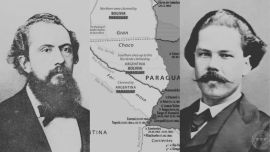At the end of last week newspaper headlines were totally dominated by the INDEC statistics bureau’s confirmation of 52.9 percent poverty, whereas on the last day of September the figure of US$276.818 billion hoarded “under the mattress” contained in INDEC’s balance of payments report was buried deep inside the news, almost as secretively as that massive cash cache. No connection was made between the two news items and yet idle capital amounting to over half of Gross Domestic Product surely goes a long way towards explaining why over half the Argentine population is poor.
“Under the mattresses” is a manner of speaking, of course – any robber who takes seriously Pete Clemenza’s Godfather advice of “going to the mattresses” when burgling a house here is almost certain to be hugely disappointed. While more money than might normally be considered prudent is nevertheless kept at home and while the estimated 800,000 safe deposit boxes in Argentine banks are generally well lined with greenbacks, most of that money is not even in the country (almost half of that in the United States and over a third in Switzerland or Uruguay as the favoured destinations).
But whatever the form or refuge chosen, it remains idle capital which might not evaporate like the historically inflationary peso but still trickles away instead of trickling down. Productivity invariably stems from the investment into capital goods and technology rather than the efforts of labour. Having lived in Germany for five years, this columnist does not subscribe to any myth of its people being extraordinarily hardworking – there an eight-hour day tends to work out to 36 hours in a week (as opposed to 48 in Argentina) because the Feierabend tradition sees nearly everybody taking Friday afternoon off while a month’s paid holiday a year is the general rule with 24 days the legal minimum. But by sheer dint of capital investment into plant, machine tools and technology in general, the productivity of Germany’s relatively indolent workforce is way ahead – just to give one example, rainy Germany produces more solar energy than any sun-drenched Mediterranean country.
If over half of the Argentine economy being placed outside the local financial system condemns over half the population to living in poverty, what are the chances of the tax amnesty whitewash renewed for this month bringing both percentages below half? Mauricio Macri’s whitewash in 2016 recovered US$116.8 billion, which was a huge chunk of fugitive capital, but by mid-2023 the Central Bank was already estimating the money beyond its reach at US$389.575 billion with some unofficial calculations as high as US$425 billion – this would point to some invisible progress this year even ahead of the whitewash. With this volatile figure progress can be as impressive as it is temporary.
If the numbers for undeclared capital can be so elastic, should we be taking the poverty figure as written in stone? Firstly, that figure does not so much represent mid-2024 poverty as the average for the first half of this year. The first quarter of this year in the wake of a mega-devaluation and two months of 20-plus percent inflation is estimated at seeing poverty reach 55 to 56 percent (almost as bad as the worst of 2002) whereas it eased in the second quarter to around 51 percent to average out at that final 52.9 percent. Such momentum should bring poverty below half the population by the end of the year but only slightly and still disastrously more than the 40.1 percent of mid-2023.
Yet beyond such admitted variations, the poverty figures of any monitor (whether INDEC or the UCA Catholic University) can be challenged at both ends. If we set an imaginary global poverty line as anything below dividing the output of a horrendously unequal planet by world population (which would be around US$12,500), then Argentina as a whole with a per capita income not much over US$10,000 would be poor with at least 80 percent of the population qualifying as impoverished, including all the middle class. President Javier Milei boasted that had he not staved off hyperinflation, poverty would be around 95 percent but by these standards it is closer to that anyway.
But there is also a case for saying that the 52.9 percent figure overshoots reality. INDEC compiles its data on the basis of asking a sample of households what their incomes are and will they always be given an honest answer? To take an extreme (but not uncommon) example, will those making money out of drugs blurt out that source of income? Drug-trafficking provides a millionaire monthly peso income even at its lowest levels so those people will not be poor. How many people are rich due to drugs? Or poor for that matter?
A rather more scientific and statistical basis for scepticism is the fact that the poverty figure of 52.9 percent almost trebles the destitution figure of 18.1 percent. Since there is a relatively fine line between poverty and destitution, it raises doubts as to whether fully a third of the population would fit into that narrow window. Poverty doubling destitution might seem more credible, thus placing the real figure of impoverished at around a third of the population – still obscene, especially with half of them destitute.
Also raising doubts in the mind of this columnist are the frequent comparisons with a Mafalda past (the 60th anniversary of that cartoon middle-class family icon was marked last Sunday), contending that until half a century ago Argentina never had more than four or five percent poverty. Looking at the images of conventillo tenements and Diego Maradona’s childhood Villa Fiorito slum neighbourhood in the 1960s, this claim becomes something of a stretch in a highly unequal society in the world’s most unequal continent.
Anyway enough of number-crunching – there is lot of talk about exit from the ‘cepo’ capital and currency controls but this column’s conclusion is that this country can never go seriously to work until all that idle capital is put to work.
As from next Monday this columnist will be abroad until the end of this month, returning to this space in November.























Comments